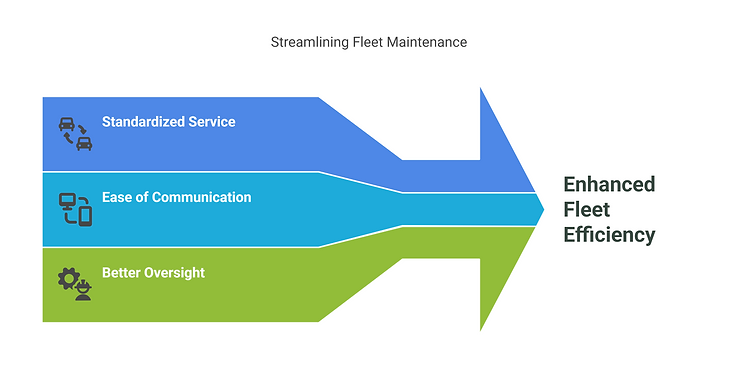With mixed fleets consisting of cargo vans, pickups, box trucks, and heavy-duty rigs, various service regimes, performance standards, and operating conditions must be juggled. There cannot be just an oil change schedule for all.
Mixed fleet managers must adopt a rational and structured service scheme aimed at reducing downtime and keeping their fleet vehicles operating at optimal levels.
Here are five ways in which you can work on enhancing performance and streamlining maintenance operations in mixed fleets
1. Centralized Maintenance Hubs for Greater Oversight
Having your fleet services centralized into one key location or a few locations could streamline your workflow and, hence, make it more efficient. These hubs allow:
- Standardized service for all types of vehicles
- Ease of communication between different teams
- Better oversight of technicians and parts
Centralized maintenance, therefore, helps to reduce delays usually caused when vehicles are routed away to shops scattered all over different locations. Also, it sets a clear expectation and process for your team to follow.

2. Integration of Telematics for Real-Time Monitoring
Telematics delivers a real-time insight into vehicle performance history for each vehicle. Getting real-time information from GPS and engine-diagnostic sources enables you to react early to:
- Fault codes or check engine alerts
- Brake wear and fluid levels
- Fuel inefficiencies or overheating
Such preventive steps will stop minor issues from becoming major repairs. Service scheduling can also be based on actual usage.
| Pro tip: To keep tabs on your fleet in real-time, it’s best to work with Kooner Fleet Maintenance and make use of telematics solutions. |
3. Mobile Maintenance Units for On-Site Service
Mobile service is a huge time saver for vehicles that return to the same depot daily, like delivery vans or service trucks. The gist with mobile units is: technicians come to your vehicles to carry out:
- Preventive Maintenance and Repairs Conducted On-Site
- Less Vehicle Downtime and More Productivity in the 24 Hours
- More Flexibility to Use Either Highly Used Fleets or Ones in Metro Areas
This, in turn, allows a more uninterrupted flow of work since the vehicles remain out there on the road for a longer time without being sent to the workshop. These allow for a more streamlined approach to fleet management.
4. Smart Scheduling for Conflicting Service
Mixed fleets are rigid with often unpredictable schedules. Smart scheduling software ensures that:
- Maintenance does not interfere with the peak operating hours
- No two critical assets get scheduled for maintenance at the same time
- Service events are scheduled about real availability, and
- Overused vehicles get flagged for a rotation
This keeps your fleet well balanced and prevents any downtime caused by bad planning.

5. Data Analytics for Better Decisions
Long-term efficiency sits on maintenance and performance data. Unplanned downtime can cost U.S. manufacturers up to 20% of their total production costs. Use analytics to maintain:
- Repeated repairs or chronic vehicle failures
- Technician productivity and use of parts
- Patterns in downtime and repair timelines
With that information, you may very well adjust your PM schedules, retire inefficient vehicles sooner, and set upon a complete working approach for superior feedback.
Conclusion
For mixed-type fleets, the objective of reducing downtime is not only to keep on schedule but to be able to use appropriate systems and insights for smarter decision-making.
Some strategies, such as centralized service hubs or mobile repairs with real-time data analytics, can help increase fleet uptime, decrease costs, and prolong vehicle life, irrespective of how diverse their assets are.
Eager to improve fleet service operations?
Kooner Fleet Management Solutions aids fleet managers across the nation in implementing sensible and scalable service systems tailor-made to mixed fleets. Call us today so we may work for you!